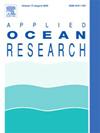Autonomous detection, localization and tracking of ships by underwater acoustic sensing using vector sensor array
IF 4.3
2区 工程技术
Q1 ENGINEERING, OCEAN
引用次数: 0
Abstract
Maritime security and surveillance demand advanced technologies for ship detection, localization, and tracking in vast oceanic environments. Acoustic sensing, particularly with Vector Sensor Arrays (VSAs), has become an efficient solution because it provides directional information of underwater sound signals. This paper presents the harbor trial of an indigenously developed, autonomous underwater vector sensor array system for detection, localization, and tracking of ships using acoustic sensing for coastal surveillance applications. The VSA system was deployed for one month, in the harbor area of Chennai, Acoustic pressure and three components of particle velocities measured by the vector sensor array are analyzed to study the different ship noise and localization of ships. In order to localize the ship noise, Direction of Arrival (DoA) and Range have been determined. DoA is estimated through MUSIC (Multiple Signal Classification) with Singular Value Decomposition (SVD) algorithm that leverage the directional sensing capabilities of VSA. Furthermore, ship tracking is performed for sequential detection and estimation to ensure continuous monitoring of ship movements. Also source level is estimated for the ships. Various acoustic levels and spectral densities are observed from the ships based on their speed, length, and distance from the VSA system. The results have been validated with the Automatic Identification System (AIS) data and they show that detection, localization and tracking of the ships using the VSA give good results. Autonomous acoustic sensing using VSA illustrates to be a promising approach for coastal surveillance and maritime security applications.
求助全文
约1分钟内获得全文
求助全文
来源期刊

Applied Ocean Research
地学-工程:大洋
CiteScore
8.70
自引率
7.00%
发文量
316
审稿时长
59 days
期刊介绍:
The aim of Applied Ocean Research is to encourage the submission of papers that advance the state of knowledge in a range of topics relevant to ocean engineering.
 求助内容:
求助内容: 应助结果提醒方式:
应助结果提醒方式:


